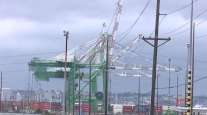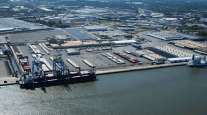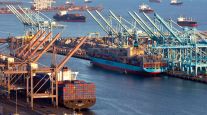Senior Reporter
Port Leaders Cautiously Optimistic for 2024
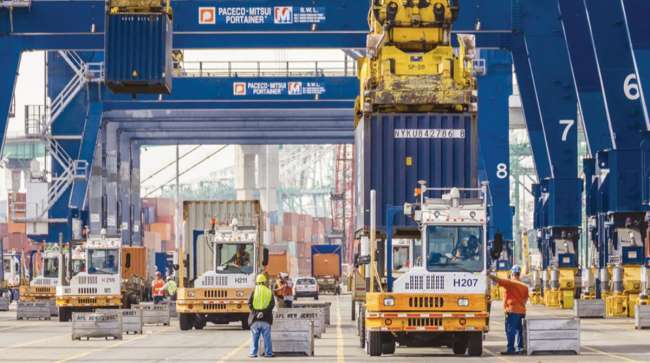
[Stay on top of transportation news: Get TTNews in your inbox.]
The nation’s port leaders are optimistic that 2024 will be good for container operators as billions in federal, state and private construction money pour into the facilities, and major projects — some already underway — allow them to chart their paths for the future.
“There is unprecedented federal investment in the nation’s ports, about $18 billion, and our industry is riding a crest, a newly formed crest and dedication to the ports,” Cary Davis, CEO of the American Association of Port Authorities, told Transport Topics. “We are entering a new era of decarbonization and digitization, and there is a lot more that we want to accomplish as an industry.”
Already, dozens of projects are underway to expand the footprint of ports, deepen waterways and reduce carbon emissions. In addition to federal funding, state governments are spending billions. California officials announced $1.5 billion is available for its container ports, with $450 million to support zero-emission projects.
Projects receiving funding include modernizing upgrades at the ports of Los Angeles and Long Beach — the busiest ports in the Western Hemisphere.

Cordero
The two ports are also seeking millions in federal and state funding to develop hydrogen hubs there.
“This is a historic grant,” Port of Long Beach CEO Mario Cordero said. “This is a pivotal moment in the creation of a sustainable green and thriving economy for decades to come, for the state of California and beyond.”
Long Beach and Los Angeles seek $150 million each, which would be matched by the ports and their tenants, totaling a potential $600 million between them.
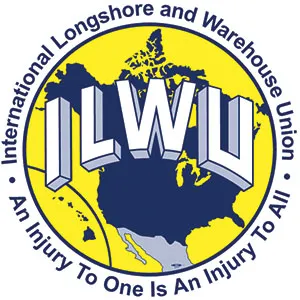
Pacific port leaders also are optimistic they will see a return in business now that labor peace is assured for the next five years. Now the focus shifts to East Coast ports, where the International Longshore and Warehouse Union, which represents 45,000 dockworkers, reaffirmed its commitment to strike if negotiations for a new contract do not reach a successful outcome by the end of September.
On the East Coast, the Port of Savannah is developing an extensive rail network with Class I railroads CSX and Norfolk Southern and shortline carriers to move cargo to other locations in Georgia. That includes 35 miles northwest of Atlanta near the state’s extensive interstate highway network, where the freight can be processed and then moved by truck.

Kemp
“Inland terminals have a proven track record of powering economic development for rural Georgians by extending port services to the doorstep of manufacturing and supply chain operations,” Georgia Gov. Brian Kemp said.
Savannah and South Carolina’s Port of Charleston are poised to play a critical role in the manufacturing resurgence in the Southeast, especially in terms of electric and battery-electric vehicles. South Korean vehicle manufacturer Hyundai is building a $6 billion factory 34 miles from Savannah, and numerous other suppliers are developing plants and factories on the heavily traveled interstate highway corridor between Atlanta and the Atlantic Ocean.

Pritzker
In the center of the country, leaders in Illinois continue to promote development of a port in Cairo that sits at the confluence of the Ohio and Mississippi rivers. Illinois Gov. J.B. Pritzker says the $40 million in state funding for the port, in a city where 36% of residents live in poverty, is “one of the largest job-creating projects in southern Illinois in a generation.”
The price tag could exceed $250 million, but permitting delays, environmental studies and questions about the port’s long-term viability have delayed the effort.
The Port of Baltimore is poised to move into the top tier of facilities in the coming years with the $500 million renovation of the 120-year-old Howard Street CSX rail tunnel that serves the port. Another project well underway is turning a former steel mill location into a 3,200-acre warehouse and truck staging area.
Good news!
From USA Trade Online, PoB through the third quarter of 2023 (Jan-Sept) performed better in cargo metrics than competing East Coast ports from Maine to Florida in each of its key targeted commodities of containers, ro/ro, autos, and forest products. @uscensusbureau pic.twitter.com/3D3FMMROFq — Port of Baltimore (@portofbalt) December 20, 2023
Extensive inland ports are either on the drawing board or under development in locations including Dallas, Salt Lake City and the Miami area.
But in the aftermath of the COVID-19 pandemic, port leaders say they have learned valuable lessons about keeping the shipping supply chain operational.
However, Federal Maritime Commissioner Carl Bentzel believes much more can be done with the existing infrastructure to quickly and reliably move freight. He said that shippers need to do a better job sharing information about where freight is in the supply chain and that there is a need for more transparency and digitization of shipping data.
.@PortofLA Executive Director Gene Seroka on shipping companies halting routes through the Red Sea: "We're watching this very closely every day."@FoxBusiness @TheKellyOGrady @SeanDuffyWI @JackieDeAngelis pic.twitter.com/Rh9PnCJHuA — The Big Money Show (@TheBigMoneyShow) December 21, 2023
He and others in the transportation and port industry also are monitoring world events. A drought in Panama has caused extensive delays for ships going through the Panama Canal, causing rates to skyrocket. In the Middle East, Yemen’s Iran-backed Houhti rebels have attacked containerships, disrupting operations in the Red Sea.

Bentzel
“I do believe there will be substantial increases in shipping costs,” Bentzel added. “There will be surcharges. It will require more insurance, and I think the larger challenge will be the delays in shipping. These shippers are under attack, and they’re threatening to take their cargo. There are a lot of issues that relate to protecting the maritime industry and we still live and work in a just-in-time world.”
Want more news? Listen to today's daily briefing below or go here for more info:


